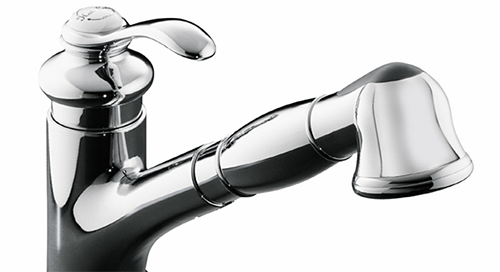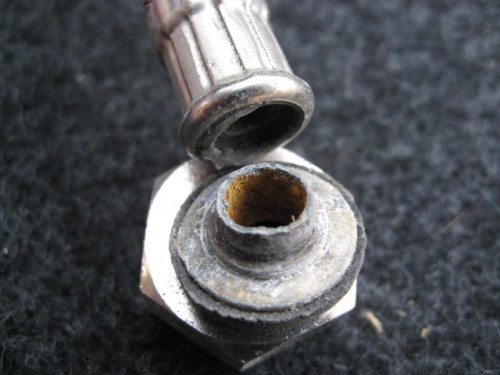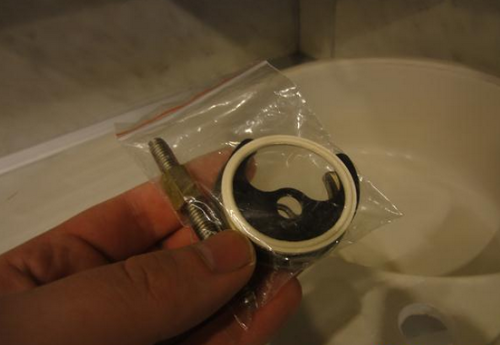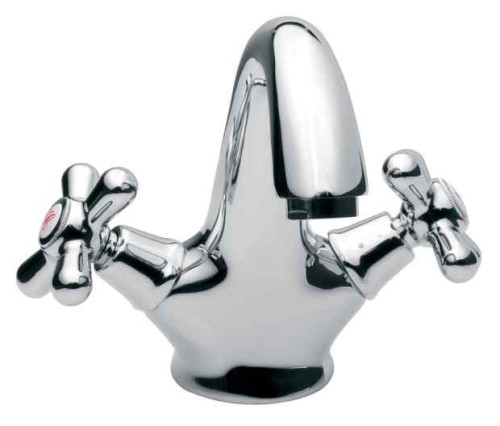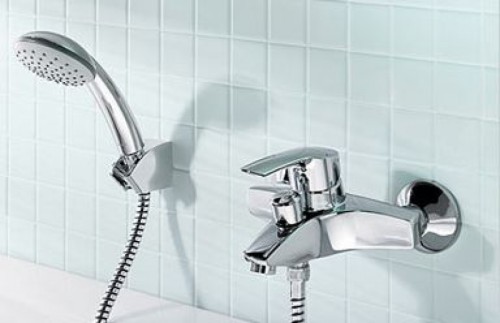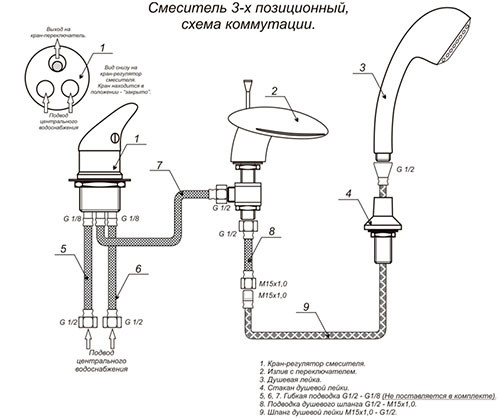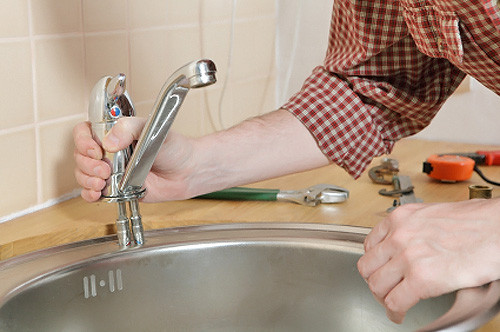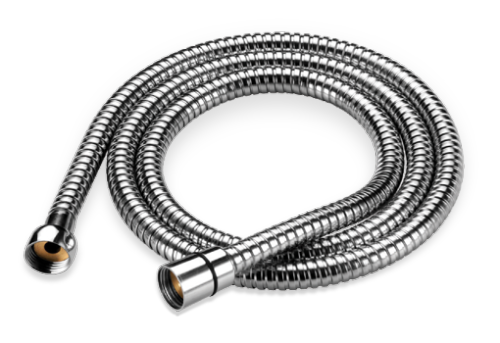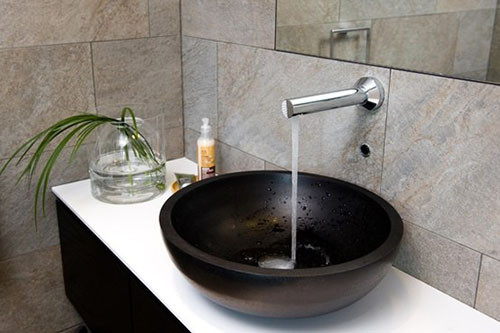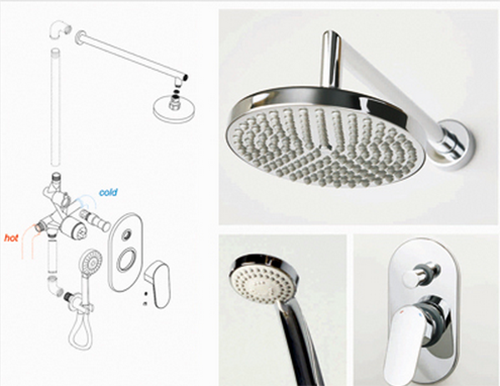If the mixer has broken in the bathroom or in the kitchen, do not rush to call the plumbing and pay for his work - installing the mixer with your own hands is so simple that you will be surprised, how cleverly you will succeed! Of course, this is not about elite plumbing products with special designs. In this article, we will touch upon the installation of classic mixers that are in every second Russian apartment, and we will also tell you what to pay attention to when choosing a model.
Content
How to choose a mixer
First of all, it should be made a reservation that the mixers for the kitchen and for the bathroom are different. In the kitchen, you absolutely do not need a shower sprayer and a hose, but you can’t do without it in the bathroom. The height of the mixer installation also plays a large role - if for washing in the bathroom a rather low crane, then in the kitchen this design will be extremely uncomfortable, because it will not be possible to wash the dishes under the mixer. It is necessary to choose a model not only in appearance, but also to the material from which the crane and handles are made, the method of switching hot and cold water, etc. Let us dwell on all these nuances in more detail.
Material for the mixer
Today, the market presents such a variety of mixer models that the head goes around, and it will be very difficult to figure out the plumbing of the new. If you do not want the crane to rust in a year or two operation, in no case do not choose silumin mixers. Silumin is a material obtained as a result of an aluminum alloy and silicon with the addition of other substances, such as lithium or sodium. Even the most expensive faucets from world -famous brands are not safe from intercrystalline corrosion, which manifests itself first in the form of small white spots (similar to lime plaque). But under the glossy coating, the metal is slowly destroyed, and once the mixer simply falls apart in his hands or bursts, while the owners are not at home.
How to recognize a silumin mixer? Pay attention to the color of the pour neck - if it is gray, then you are dealing with silumin. Pour is a part located above the sealing ring on the root of the mixer. Such mixers are much easier than other materials, so weigh several models in your hands for comparison.
In order not to lose, choose bronze or brass mixers. Models from these metals can work properly for decades, needing only in periodic cleaning, like any other plumbing.
Another important point is the material of the seals. They should be made of dense rubber, but in no case from plastic, even if the seller claims that this is an ultramodern and durable material. Today, only rubber can provide a reliable and sealed connection.
In most cases, the spacer ring of spout is supplied separately from the mixer and lies in a package with mounts and small details. Many inexperienced plumbing do not understand why it is needed and do not install it, as a result of which the spout is very quickly shaken and begins to flow. Therefore, be sure to buy the presence of this ring when buying a mixer.
The split spacer should be very tight. It is placed on the root of the spout before inserting it into the nest. Since the ring is tight, it may not enter the hole the first time, so it must be squeezed on the sides and pressed with a click.
Controversial reinforcement
The device of the faucet crane plays an important role when choosing a model. And this is not at all about the convenience of operation - the fact is that various methods of opening and overlapping water affect the life of plumbing. Previously, there were only valve two -handed taps, and have recently corking with one lever.
Professional plumbing recommend choosing a mixer with two handles only if you do not imagine your kitchen or bath without it. Modern lever models surpass two -handed in all respects.
Why lever mixers are better than two -handed:
- They consume water more economically - in the mixer with two handles, you first open cold water, and then gradually add hot (and it rarely starts to flow at once), at this time the water flows nowhere. In a lever mixer, you can immediately open it so that warm water pills, and then only slightly adjust the position of the handle. In addition, overlap water with a lever mixer is much faster - you just need to lower the handle down, and the taps will have to be twisted much longer.
- Efficiency - in valve cranes, the spool and a knee with a saddle give a hydraulic resistance 5 times higher than in a valve tap, where the water goes calmly. If the pressure drops in the system, then in the two-handed tap the water will barely drip, and in the lever due to small resistance, a normal stream will remain.
- Convenience - most of us grew during the time of the valve cranes and it was necessary to gradually get used to the lever cranes. It was new to use them, but if you figure it out, the process of turning on/off/adjusting water and pressure itself began to require much less effort. You no longer need to twist two pens - press the lever or turn it to the side a little stronger. Now, having washed his head, with his eyes closed, it will not be possible to open hot water instead of cold water - the handle is only one.
In general, wherever you look, there are only pluses. But some users complain that if you sharply open a lever crane, then this can provoke a hydraulic system, and all the pipes will burst. This is a partially true statement, which over time has grown with myths and guesses, and now misleads inexperienced people. In the very first watering urban systems, indeed, cork cranes with a longitudinal slot in conical traffic jam were put, and during the sharp opening they gave hydrogen with understandable consequences in the form of bursting pipes. Since the plastic pipes have not yet come up with, the plumbers found the only reasonable way out - replace the plugs with the screws that open gradually.
In aviation, more than 100 years ago, taps with spherical, not cone, cork and round, and not longitudinal, opening were invented. That is, in fact, such a crane is not able to create a hydraulic system. Moreover, he is not even able to flow, because in the process of wear, the pressure of the water coming from the pipe presses the cork to the saddle along the entire circle. And the latter-such an “air frame” is much cheaper and easier in production. It is unclear why, but the aviators did not want to share their invention with plumbers for a long time, but during perestroika, the case moved from a dead point, and today spherical cranes almost completely supplanted the spool valve structures.
Soul Disper
So, when you stopped looking towards the valve cranes, it is time to decide on the “sunflower” of the shower mixer. The water diffuser must be equipped with self -cleaning nozzles. It is very easy to determine them - on each hole there is a soft rubber or polymer nozzle with a hole. When you turn on or turn off the water, the nozzles are opened and narrowed accordingly, dropping the lime plaque. If the nozzles are made of hard static material, then they will clog sooner or later, and the head will begin to spray in different directions.
Replacement of the mixer in the bathroom
In this chapter, we will consider various ways to install mixers for the kitchen and bathroom. Any owner or mistress can easily cope with all of them, making sure that sometimes with your own hands you can do what others pay impressive amounts to plumbers.
Before starting work, it will be useful to familiarize yourself with the installation circuit of the mixer. The image below shows the assembly scheme of the 3-position mixer for the bathroom. We remind you that the specifics of the installation depends on the type of design and its location - in the kitchen, in the bathroom on the sink, on the side of the bath itself, etc.
To work, you will need a gas (divorce) key, vinyl island and a hammer. Island is needed for winding nickelled nuts before they are tightened. This will save the coating intact. You will dismantle the old mixer with a divorce key.
Particular attention should be paid to the waterproofing of the places of docking the elements of the mixer. If earlier for this they used a linen coil, today it is better to purchase a feed tape. It is wound in 15 layers clockwise (as the thread is on) so that when winding the nut, the tape seals the thread and prevent the slightest chance of leaking out to the water. It is very simple to understand that you wound the tape in that direction - when winding the nut, it will slide, and there can be no talk of any waterproofing in this case.
Dismantling the old mixer
Before proceeding with the disassembly of the old mixer, be sure to block the water in the pipes! The most important problem when working with structures that have not changed about 20-30 years is their unwillingness to unwind. Over many years, saline precipitation intensified in the places of fasteners and turned into real stones. And if you can’t unscrew the mixer with a gas key, then do not tear your hands and risk breaking a pipe - there is a proven folk remedy. Take kerosene or brake liquid and drop 5-7 drops on a petrified joint. After 10-15 minutes of waiting, try to work again with a divorce key-the fasteners should succumb. If it does not help, use the VD-40 tool, which instantly removes rust, plaque and other blockages from metal surfaces.
It is better to substitute a bucket or pelvis under the mixer so that the water remaining in it does not get to the floor. After you unscrewed and removed the mixer, disconnect the hoses of hot and cold water from the tap. Sometimes this is easier to do before unscrewing the mixer. It is better to do this work on a basin, because there is almost certainly water in the hoses, even if you blocked the valve.
Installation of a new mixer in the kitchen
Before installing the mixer in the kitchen, prepare the free space and cover with a film or rags all the surface nearby, which can be damaged by water or an accidentally abandoned tool. It is better to rearrange the equipment for the duration of work in another room (the refrigerator can be left in place).
You may not be enough for one divorce key, so it is better to stock up on a couple of screwdrivers, pliers and a set of wrench. You will also need a drain corrugated or all -metal hose (2 pcs.), Moreover, its length should be determined in advance. The hose will go from the drain of the sink to the sewage drain, and it is desirable that it does not bend, otherwise the potential place of the blockage will be created at the place of fold.
Cross hot and cold water. If possible, slightly push the sink from the wall to free up more space for work.
Installation of the mixer on the sink:
- Connect the eyeliner hose to the mixer from the short fitting side (this is a metal rod with thread).
- Remove the bronze nuts from protective hairpins and spin the stilettos until stop.
- Through the opening in the sink, pass the hose to the mixer, and connect the second hose from the bottom to the corresponding hole in the mixer.
- When the mixer is already standing on the sink, and two hoses are connected to it, put on it a rubber sealing gasket and, clutching a metal plate, wrap the bronze nuts on the studs.
- Tighten the nuts with a suitable key, but do not pull them so as not to damage the sink or not to tear the thread.
- Connect the hoses leaving the mixer to the water supply. The most difficult thing here is not to confuse them. To do this, turn the mixer with a tap on yourself: the right hose is cold water, the left is hot.
- Attach the hoses to the water pipes.
- Check the density of the joints (2 for the mixer and 2 for pipes).
- Turn on the water and check the operability of the mixer. Before turning on, make sure that the crane is twisted or the lever is lowered.
Video about the installation of the mixer will give a complete picture of this work:
Installation of a new mixer in the bathroom
The installation of the mixer in the bathroom occurs a little differently than in the kitchen, and there can be several methods of installation-on the wall above the bathroom, in the washbasin and on the side of the bath. If you need to put the mixer in the washbasin, use the instructions presented above - there is no particular difference there.
Consider the installation of a shower mixer, which is attached to the wall, since this is the most common option:
- Cross hot and cold water. If the taps turn tightly, treat the threads of the thread with grease and try again. After that, check if the water flows with the valves of the mixer open.
- Using a divorce key, unscrew two nuts on the eccentric.
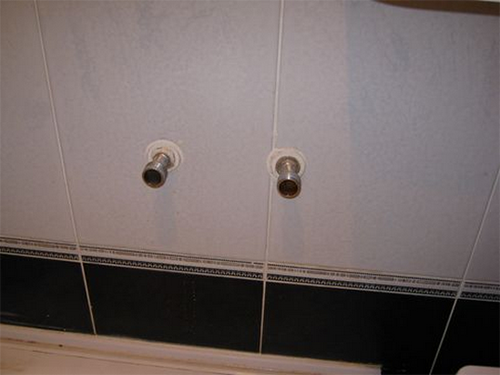
- Dismantle the old mixer.
- If the eccentrics are in good condition, they can not be changed (brass). Unfortunately, in most cases, in Soviet houses, eccentrics have long been left to be desired, so they should be replaced. Click on the wall with a gas key and start turning counterclockwise. Unscrew very carefully so as not to break an eccentric - if this happens, you will have to disassemble the wall.
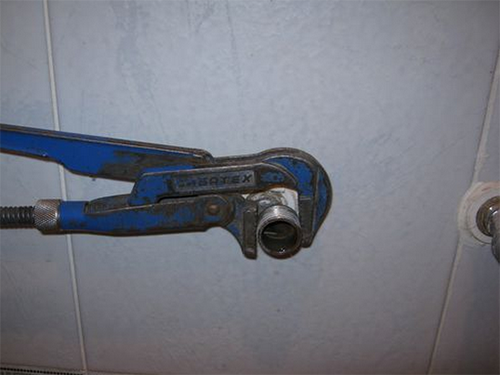
Useful advice: if the old iron eccentric does not give in, heat it with a lighter or flame of a candle and try to unscrew it again. - To unscrew the old Soviet eccentrics, insert one plowmen claw into the hole and try to crank it from the inside. If there is not enough strength, click the pliers with a gas key, which will act as an additional and more convenient lever. The process is more clearly visible in the image below:
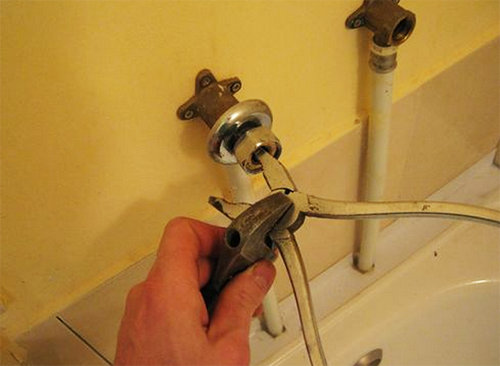
- In the pipe after removing the eccentric, you can see the old linen winding. Remove it, otherwise the new crane will instantly clog.
- Clean the inner surface of the pipe from the plaque and wrap the feed tape on new eccentrics.
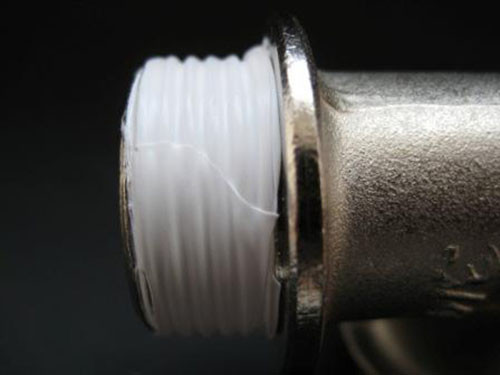
- Scroll over the eccentric tape into the thread clockwise. Make sure that the eccentrics are located strictly symmetrically. For convenience when tightening the first eccentric, consider the number of revolutions.
- To correctly install a horizontal mixer, wind it without a sealing tape per eccentric, attach to the second and check the horizontal level by the construction level.
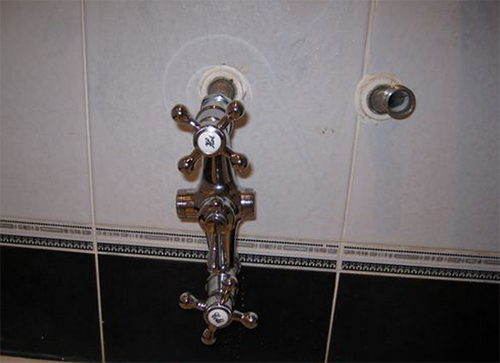
- If everything is even, remove the mixer and install gaskets on it.
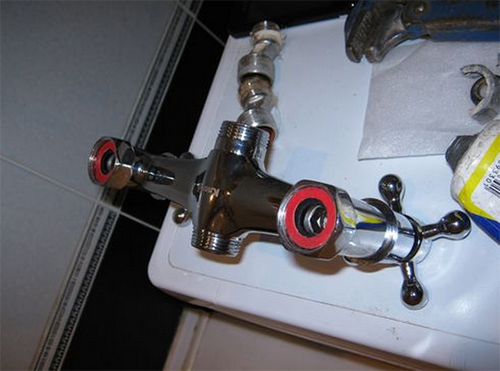
- On eccentric, screw up decorative cups until the end of the thread.
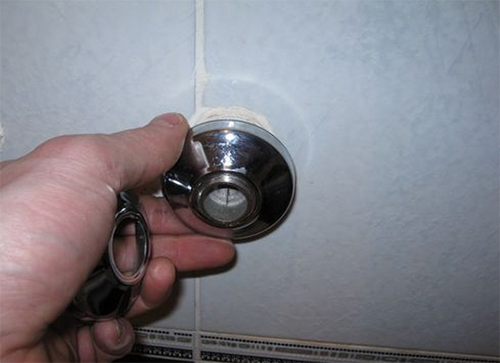
- Start winding the chipper nuts on the eccentric first manually, and then with a divorce key. Tighten only slightly so as not to disrupt the thread.
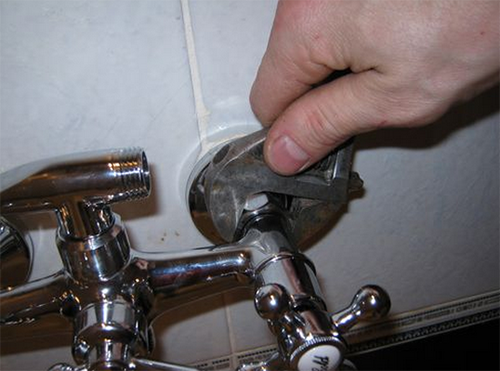
- Attach the hose with a shower watering can and other elements.
- In order not to cut the oil seals, pre -lubricate them with liquid soap.
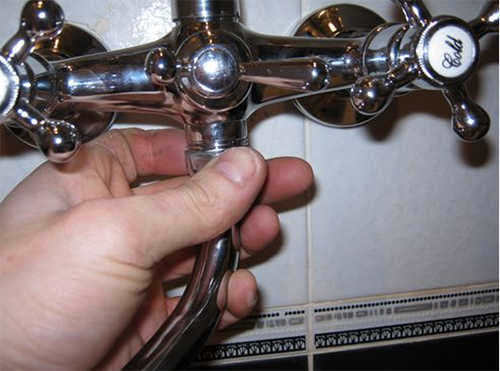
- It remains only to unscrew the valves of the supply of hot and cold water and check the operability of the mixer.
The process is shown more clearly in the video below:
The installation of the mixer on board the bath occurs according to the same principle as on the sink, the only difference is that the hole for the tap is located not in the sink, but in the bathroom body.
Hidden mixer
More and more people prefer to replace ordinary faucets with a hidden type design - they look very interesting and aesthetically pleasing. However, the installation of a hidden mixer requires knowledge and skills, so it is better to entrust it to a specialist, especially if you have not had to change plumbing before.
Any hidden mixer consists of three components:
- mounting box;
- functional part (mixer);
- decorative external panel.
The main difficulty is that there is no universal way of installing such hidden mixers - it all depends on the configuration of the model and on the variety of the mixing unit. Therefore, if you are not sure that you will deal with the installation instructions attached to the mixer, it is better to use the services of professional plumbers.

